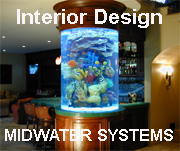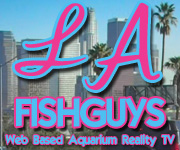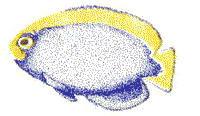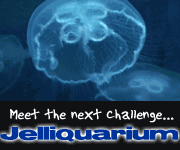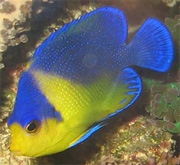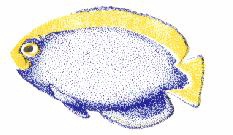|
Corals, Family of Anthozoans
By Jim Wolf, Marine Biologist
There about 6000 species of anthozoans, and they all exist exclusively
as a polyp. There are two general groups of anthozoa that will interest
the hobbyist. The first is the anemones and true corals. These animals
usually can be readily identified as a Cniderian due to their large conspicuous
polyp like structure. The other group are the gorgonian like animals. These
animals are a bit more difficult to characterize. Soft corals, sea pens
and gorgonians all are included in this group. Usually the polyp is quite
small, and will bear eight tentacles. A fairly crude yet accurate way to
tell the difference is that many octocorals do not resemble anemones at
first glance. The specimen may appear tree like, feather like, and or encrusting
and the tentacles will bear smaller tentcles (pinnate).
One of the most fundamental points regarding Anthozoan biology is their
sessile lifestyle. Unlike fish and other mobile critters, most Anthozoans
can not move from a particular space if they do not like it. These organisms
rely on the water to bring food and oxygen to them, as well as take waste
products away.
The three primary ways in which Anthozoans feed are: predation, suspension
feeding, and "farming". The predation method is perhaps the most familiar.
Many anemones and large corals will sting a small shrimp fish or other
food item to death. It will then transport the prey to its mouth for ingestion.
Almost all Anthozoans will eat some food in this manner. Suspension feeding
is a common method in the Octocorals (gorgonians, sea pens, soft corals,
etc.) and all Anthozoans feed to some extent in this way. This method involves
the capture and collection of microscopic food particles on a sticky surface
of the animal. After a large amount of these "microscopic morsels" are
stuck, they are transferred to the mouth for digestion.
Many species of corals and anemones actually "farm" algae living in
their tissue. This algae is called Zooxanthelle, and strikes a symbiotic
(mutually beneficial) relationship with the coral. The algae provides food
and oxygen to the coral, and in exchange receives nutrients and a protected
place to live. The coral can derive up to 90% of its food needs from the
algae! A powerful light source is required to insure that the algae can
produce enough food, other than light, many Anthozoans do not require much
additional feeding.
Anthozoans usually consist of greater than 90 percent water. To rid
itself of waste many Anthozoans will simply "wring themselves out". A football
sized anemone can easily contract to a fist sized lump. This is a crucial
point, since anemones placed too close together may expand and come in
contact, resulting in injury. This aggression is a common cause of injury
in many reef building hard corals so they need adequate space around themselves
to accommodate expansion. Since corals can not move, the most common way
to get new space for growth is to simply sting your neighbor to death and
overgrow them!!
HERMATYPIC
CORALS AND ANEMONES. If your coral or anemone contains Zooxanthelle
algae, it will usually appear bright green or brown, and will fluoresce
under ultra-violet (U.V. or actinic) light. If this is the case, then your
Anthozoan belongs to a group of hermatypic, or light loving species. Place
them in an area of good lighting and water flow, and insure that they do
not come in contact with each other or any equipment (even when expanded!!).
If provided with lots of light ( See
reef lighting ), most hermatypic Anthozoans need only an occasional
supplemental feeding (apx. once a week), of trace elements (Specifically
iodine, molybdenum, strontium, calcium) and an organic coral food.
AHERMATYPIC CORALS. These anthozoans do not require light to survive,
are usually brightly colored and will not fluoresce under U.V. light. These
Anthozoans, like hermatypic corals enjoy good water flow and proper placement,
but want reduced lighting, and increased feeding. Since they can not rely
on algae for food, they must be fed more regularly. Directionalized feedings
of small plankton, and supplemental liquid invertebrate foods are a good
start.
ZOOANTHID
AND ENCRUSTING OCTOCORALS. These organisms look like very small anemones.
They usually have eight or multiples of eight tentacles, and you could
easily place 5 on a quarter! Most enjoy light, but check for fluorescence
to be sure. These organisms require FAST water flow, and an ample supply
of liquid invertebrate food and supplements. It is not uncommon for the
colony to shrink a bit at first, but under good conditions, they will grow
and colonize new space!
SOFT CORALS.
These Anthozoans usually resemble gelatinous blobs with small polyps. A
general rule for these organisms is the more dull the color, the more need
for good quality lighting. Again, water flow and liquid supplements are
the rule. Occasionally part of the colony may become necrotic (start to
decay). To ward off further decay, QUICKLY wash off the affected area with
a strong stream of cool FRESH water, and QUICKLY return the specimen to
the aquarium (this will work for almost any colonial Anthozoan experiencing
decay. Many sort corals can expand dramatically, and some even like to
be hung upside-down! So inquire about the habits of your specific soft
coral.
GORGONIANS
These are some of the most dramatic and demanding of the Anthozoans. They
require a powerful continuous water flow, preferably oscillatory (to and
fro). Gorgonians need to be anchored firmly onto the rocks, in an area
of diminished lighting, and enjoy frequent small feedings. Many gorgonians
can not be kept successfully in aquariums that lack of suitable food. A
diet of living plankton (fed at night, when the colony is feeding) substantially
improves their chances for success. Also avoid putting them into tanks
with lots of mechanical filtration, since this will filter out their food
before they have eaten their fill.
TUBE ANEMONES AND SEA PENS. These two groups are distantly related,
but share a common need for sandy substrate. They should be placed in a
part of the tank with at least three inches of sand. This will provide
them with a space to anchor their "foot". Tube anemones are voracious predators
that can expand dramatically. They could possibly catch and consume an
unwary tank mate, so be for- warned!. Feed them about twice a week when
they are fully expanded. Sea pens are totally harmless, and require strong
unidirectional flow, diminished light, and frequent liquid feedings. |

